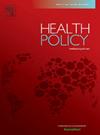Regulatory approaches towards AI Medical Devices: A comparative study of the United States, the European Union and China
IF 3.6
3区 医学
Q1 HEALTH CARE SCIENCES & SERVICES
引用次数: 0
Abstract
The swift progression of AI within the realm of medical devices has precipitated an imperative for stringent regulatory oversight. The United States, the European Union, and China stand as vanguard entities in the regulatory landscape for AI-enhanced medical devices, each delineating unique regulatory frameworks. The European Union is renowned for its avant-garde approach to AI legislation, placing a significant onus on data security. Conversely, the regulatory paradigm in the United States is characterized by its market adaptability and flexibility. Meanwhile, China adopts a comprehensive and process-oriented approach towards the regulation of AI in medical devices. A comparative analysis of regulatory mechanisms across the United States, the European Union, and China reveals that the articulation of coherent technical review standards, the critical points of AI regulation including the emphasis on data consistency evaluations, the integration of clinical trial data to an appropriate degree, and the implementation of forward-looking strategies for software modification control, etc.. Jurisdictions beyond these leading entities are advised to assimilate the regulatory insights from these frontrunners for a more balanced regulatory framework, tailor them to the unique exigencies of their respective locales, institute a definitive ethical framework, and astutely establish core evaluative benchmarks on algorithm interpretability, consistency, and clinical validity.
人工智能医疗器械的监管方法:美国、欧盟和中国的比较研究
人工智能在医疗设备领域的迅速发展,促使严格的监管势在必行。美国、欧盟和中国是人工智能增强型医疗设备监管领域的先锋实体,每个国家都划定了独特的监管框架。欧盟以其对人工智能立法的前卫态度而闻名,对数据安全负有重大责任。相反,美国的监管模式的特点是其市场适应性和灵活性。与此同时,中国对医疗器械中的人工智能采取了全面的、以过程为导向的监管方式。通过对美国、欧盟和中国监管机制的比较分析,我们发现,制定连贯的技术审查标准、重视数据一致性评估、适当整合临床试验数据、实施前瞻性软件修改控制策略等是人工智能监管的关键点。建议这些领先实体以外的司法管辖区吸收这些领跑者的监管见解,以建立更平衡的监管框架,根据各自地区的独特紧急情况进行调整,建立明确的道德框架,并敏锐地建立算法可解释性、一致性和临床有效性的核心评估基准。
本文章由计算机程序翻译,如有差异,请以英文原文为准。
求助全文
约1分钟内获得全文
求助全文
来源期刊

Health Policy
医学-卫生保健
CiteScore
6.40
自引率
6.10%
发文量
157
审稿时长
3-8 weeks
期刊介绍:
Health Policy is intended to be a vehicle for the exploration and discussion of health policy and health system issues and is aimed in particular at enhancing communication between health policy and system researchers, legislators, decision-makers and professionals concerned with developing, implementing, and analysing health policy, health systems and health care reforms, primarily in high-income countries outside the U.S.A.
 求助内容:
求助内容: 应助结果提醒方式:
应助结果提醒方式:


